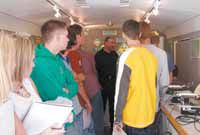| Tom Kerr uses geiger counter to show students how radiation can be blocked in various ways. |
In a effort to educate Carbon County emergency responders and science students about radioactivity, a representative of the Idaho National Engineering and Environmental Laboratory (INEEL) recently visited Price for a three-day seminar on Sept. 16-18.
INEEL speaker Tom Kerr travels throughout the country lecturing about the basic principles of radioactivity and how to respond to incidents involving radioactive materials.
Radioactive materials can be found in several common household items, including smoke detectors and televisions.
Many commercial products, including band-aids and makeup, are sterilized with radiation.
According to the INEEL, radiation is the energy emitted from radioactive materials the way light is the energy that comes from the batteries in a flashlight.
During the anthrax scare, contaminated mail was exposed to radiation to kill the bacteria.
It can also be found in the environment in rocks and soil, and even in the human body from food such as bananas and potatoes.
Kerr asserted that minimum amounts of exposure to radiation is inevitable, as most things are radioactive to some degree.
However, when dealing with situations involving substantial amounts of radioactive materials, he said precautions must be taken.
There are three keys to controlling radiation, according to Kerr. The first is to minimize exposure time to any radioactive materials.
The second is to maximize the distance from radioactivity and the third is to use shielding when exposure is possible.
Kerr said many items in an immediate area may be used as shield. For instance, sttanding behind a car or at the edge of a building can create the necessary particle shield that is needed to guard against the radiation.
Situations that could require emergency responders to be exposed to radioactive materials might include accidents involving vehicles which transport it or terrorist acts involving radiation emiting devices.
Kerr said he believes the seminars will help emergency responders feel prepared if they are ever faced with a situation involving radioactive materials.
“What I really hope they take away from it is that radioactive material is all around us and you can handle it if you know what you are doing,” he stated.
In addition to the classroom lectures, Kerr also enhanced the presentation with a portable science lab.
The lab, a convenient tow trailer, was filled with different examples of radioactive materials, measurement tools, and items that can block radiation emissions.
The INEEL presentation took place at Carbon High School and was arranged by Carbon science teacher Bill Krompel.

